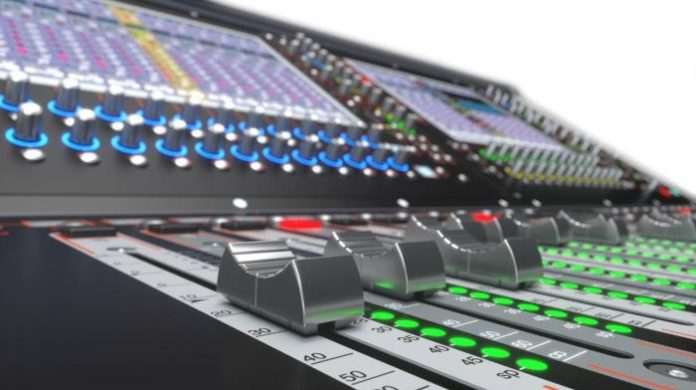DiGiCo has released its newest console, the SD12, in a series of unveilings around the world before presenting it at NAMM in California.
According to DiGiCo’s David ‘Webby’ Webster: “We have shipped our SD12, nicknamed Project Vulcan, to more than 30 distributors around the world, so the console will officially launch at 10:00am in each territory’s time zone, beginning with Australia and New Zealand 19 hours prior to the NAMM show unveiling. Having customers all over the globe be able to see, touch and hear this exciting new product on the same day is absolutely unprecedented for the pro audio industry, and we know that it’s going to deliver a reaction that is out of this world!”
The SD12 is the culmination of everything that DiGiCo has learned over the last decade and a half and encapsulates the best features of both the SD and S Series’. Utilising the latest generation of Super FPGA, it is compact in size but delivers the power and capability that is now synonymous with DiGiCo consoles.
The SD12 features 72 input channels with full processing, 36 aux/group buses with full processing, a 12 x 8 matrix with full processing, LR/LCR buss with full processing, 12 x stereo FX units, 16 x Graphic EQs, 119 x Dynamic EQs, 119 x multiband compressors and 119 x DiGi-TuBes, 12 x Control Groups (VCA) and SD Series Stealth Core 2 software, making it compatible with all other SD Series sessions.
One of the SD12’s outstanding features is its dual 15-inch digital touch screens – previously only seen on the SD7 and SD5 – which provide 24 channels in one view, dual operator mode and the ability for the right-hand screen to be the Master, as well as advanced connectivity via optional DMI cards, yet the SD12 still maintains a workflow that will be familiar to anyone working in live touring, corporate, installation, house of worship, theatre or broadcast.
EQ and dynamics controls are aligned perfectly next to both the left and right-hand screens, so that they sit adjacent to the graphic representation that you see when you assign an EQ. Unusually for a console this compact, DiGiCo has included its famous Hidden Til Lit (HTL) technology, with two banks of 24 encoders featuring an RGB HTL ring, as well as an SD7-style channel strip with HTL EQ encoders. There is also new Dynamics metering on the channel strip and new high intensity meters associated with the faders. The rotaries that sit below the screen indicate, by colour, what parameters they are controlling to allow for fast operation; these are also HTL.
One of the other important things with a digital console is the feedback of the metering. The Dynamics controls are exactly where you would expect them to be, but with the addition of gain reduction meters normally only seen on the SD7 and SD5 and metering to show the action of the gates making the feedback from the worksurface unrivalled at its price point.
There is also an assignable Master section on the bottom right hand side of the worksurface, again only previously seen on an SD7 or SD5, and two assignable faders with their own displays and metering, which can be assigned to be any of the channels whether input or output, or solo master controls. Dedicated RGB scribble strips, of which there are five, can be assigned to macros with five banks giving a total of 25 macros, and there is a snapshot panel for quickly accessing and controlling the snapshots list, as well as for firing the next and previous snapshot.
On the back of the console is a standard local I/O format. There are eight local mic/line inputs, eight local line outputs and eight AES/EBU in/out for local digital sources, as well as two MADI ports, plus a UB MADI connection for recording at 48kHz; 48 tracks of recording are possible with the console clocking at 48kHz and 24 tracks if it is clocking at 96kHz.
There are two slots for DMI cards. Options include a Dante module, which can be plugged straight into the back of the console, alleviating the need to purchase an Orange Box. A Waves module can also be fitted to take full advantage of the SoundGrid platform. In fact, there is a huge family of DMI cards that can be plugged in the SD12, which can be changed between different projects or tours, depending on requirements.
Adding to its already considerable benefits, the SD12 has a suite of remote control options, including the iPad SD remote app which offers remote control, expansion and show control. Offline software, meanwhile, allows for session preparation and online remote. There are OSC and Ross network protocols; 16 pin GPIO that allows for audio follows video and show control; Serial/MIDI in/out for MMC/MTC, MIDI remote and QLab; second console mirroring and redundancy.
As the SD12 is an SD Series product, there is also the option to upgrade straight into the Optocore network with not one, but two loop options, allowing the SD12 to sit happily anywhere on a loop with any other Optocore-enabled SD product.
“The SD12 has already created an international impact, with over 30 of our distributors taking part in a surprise global launch, details to follow shortly,” said DiGiCo MD James Gordon. “The SD12 takes all the true DiGiCo values and installs them into a compact, cost effective surface with unrivalled feedback and control. It is ideal for operators that demand the best audio quality, combined with an intuitive and fast multi-screen worksurface.”
To view a video of Audiotonix/DiGiCo Managing Director James Gordon previewing the new SD12, visit: https://youtu.be/0BAtQj6ggl4






